5



Heritage 2016, www.plaintalk.net
Vermillion Plain Talk
5B
Episcopal Church
St. Paul’s Serves Community For More Than 100 Years
BY DAVID LIAS
david.lias@plaintalk.net
During the summer of 1909, the
the Rev. James Henderson, a Massachusetts native who had only
recently completed his theological
course, was appointed to serve
the St. Paul’s Episcopal Church in
Vermillion, according to Herbert
S. Schell in his book “Clay County:
Chapters Out of the Past.”
Schell notes that Henderson
was probably better known for a
secondary role as athletic director
at the University of South Dakota
than for the five-year term of service at St. Paul’s. An outstanding
athlete during his college days,
especially in football, he was appointed to the university position
during the summer of 1911. The
record made by university teams
under his direction remains unparalleled to the present day. Particularly outstanding was the 1912
football season, which included
a 10-7 victory over the University
of Minnesota and a single loss to
Michigan by the score of 7 to 6.
In his role as vicar, the Rev.
Henderson was called upon by
his bishop to conduct services in
various parishes standing vacant at
the time. Among them were pulpits
in Armour, Huron, Hurley, Mitchell, Parker and Springfield. In one
instance, however, he conducted
services by special invitation. Following the defeat of the Agricultural College at Brookings in 1911, the
winning coach stayed over for the
following day in order to conduct
regular morning and evening services at the local Episcopal chapel.
He resigned during the summer
of 1914. Following a wedding
ceremony in New England, he and
his bride left for Spokane, Wash.,
where he became headmaster of an
Episcopal boys’ school.
With the assignment of the Rev.
Rainsford Boag to Vermillion a little
later, St. Paul’s reached a new stage
in its growth, closely related to the
university’s progress. A growing
BY DAVID LIAS/FOR THE PLAIN TALK
The present chapel of St. Paul’s Episcopal Church was built in 1951, and has remained much the same
until the summer of 1996 when a Guild Hall was added on to the north side of the building.
student body, accompanied by a
larger teaching staff, was inevitably
reflected in an increasing number of Episcopal communicants.
Added prestige for the local chapel
followed the appointment of Dr.
Robert L. Slagle, a devout Episcopalian, to the university presidency
in 1914. President Slagle was soon
designated a lay reader, taking
charge of regular services whenever the Rev. Boag was called upon
to supply some other town. Other
appointments as lay readers followed in subsequent years so that
St. Paul’s was seldom to be without
regular services in the future.
A close identification with the
university community was viewed
by the church hierarchy as a major
function of the Episcopal organization in Vermillion. The Canterbury
Club, which remained active for
many years, was specially devised
for this purpose. At times, as
in 1951, the club’s membership
included 125 university students.
On some occasions, such as during
periods of special missionary activities, separate afternoon meetings
were scheduled throughout the
week for the university students.
The housing of young men of
Episcopal persuasion was a cause
of particular concern. One of the
objectives sought from the ill-fated
High Street project was to provide
rooming accommodations for
college students. Several actually
resided there for a few months.
Years later these would recall the
college pranks they indulged in
during their brief dormitory life.
After 1900, Episcopal students
frequently found quarters available
to them at the rectory. This was
especially true during the tenure of
James Henderson.
Plans for a separate building for
dormitory purposes, finally, saw
fruition in 1917. During the early
part of the year the widow of Bishop George Biller, who had recently
passed away, headed a special
drive raising S4,000 for a two-story
building called Biller Hall. The
structure, attached to the rear of
the chapel, was large enough to
accommodate 30 students. The occupants were to provide their own
bedding and pay a small assessment to cover lighting and heating
costs. According to the Dakota
Republican, Biller Hall housed 20
young men in the fall of 1919. No
information is available for the
preceding two years. The building,
however, was not used beyond
1920 for dormitory purposes. The
Rev. Graeme Davis was the vicar at
the time, maintaining a residence
for his family in the town.
After a lapse of about a year following the resignation of the Rev.
Davis, Bishop Hugh L. Burleson
assigned his brother, then residing
at Rochester, N.Y., to the Vermillion
mission. The Rev. John K. Burleson,
the new vicar, had formerly served
a parish at Grand Forks, N.D. for a
period of 16 years. Two years later,
in 1923, he vacated his charge at
St. Paul’s to become rector of the
Springfield parish as well as the
headmaster of St. Mary’s School
for Indian girls which was to be
re-established in Springfield by
the Episcopalians in the fall of that
year.
By the 1920s it was becoming
quite evident that the eventual
absorption of the church acreage
adjoining the university campus
on Dakota Street was only a matter
of time. Several lots were, accordingly, purchased at the southeast
corner of Main and Linden in 1927,
followed by the construction of
a rectory two years later. The
chapel on Dakota Street, however,
remained in use until 1951 when a
new church edifice was dedicated
on Linden Avenue. The old church
grounds, in the meanwhile, had
been acquired by purchase by
the state to become a part of the
university campus. Finally, in 1959.
the old chapel which had been
moved from High Street in 1894
was torn down to make room for an
additional wing to Julian Hall.
UCC-Congregational
Nearly 150 Years Of Dedication To The Community
The first Congregational Church of Vermillion was organized in September 1870, with seven members. After
meeting in a variety of places over the next three years,
including the old log schoolhouse, the church finally
moved into its own building in May 1873. This image is
from an old edition of the Vermillion Plain Talk.
BY DAVID LIAS
david.lias@plaintalk.net
The first Congregational
Church in Vermillion was
organized in September
1870, with seven members.
After meeting in a variety of
places over the next three
years, including the old log
schoolhouse, the back room
of the Lee & Prentis building,
and a rented building on
Broadway, the church finally
moved into its own building
in May 1873.
Located below the bluff,
the church and most of its
contents were destroyed in
the flood of April 1881.
After the flood, the
Congregationalists rebuilt
their church on top of the
bluff. The building, located
on the second block of High
Street directly across from
DAVID LIAS/FOR THE PLAIN TALK
The United Church of Christ—Congregational building was dedicated on Feb. 17, 1929, and the colonial architecture
sets it apart from other churches in town.
the Jolley residence, was
dedicated in November 1881.
In 1925, the
Congregational Church
planned to sell their old
building and construct a new
one of colonial architecture
for $75,000 on the same site
fronting Forest Street and
to move the manse to the
south. In 1928, the Masons
sold their lots a block away
on the north side of Main
and Harvard streets to the
Congregational Church for
$5,000. The new building was
dedicated on Feb. 17, 1929,
and the colonial architecture
sets it apart from other
churches in town.
Celebrating 150 Years
1865-2015
St. Paul’s
Episcopal
Church
10 Linden Ave.
Vermillion, SD 57069
605-624-3379
StPaulsVermillion.org
Holy Eucharist
Sunday, 10am
Father Paul Sneve
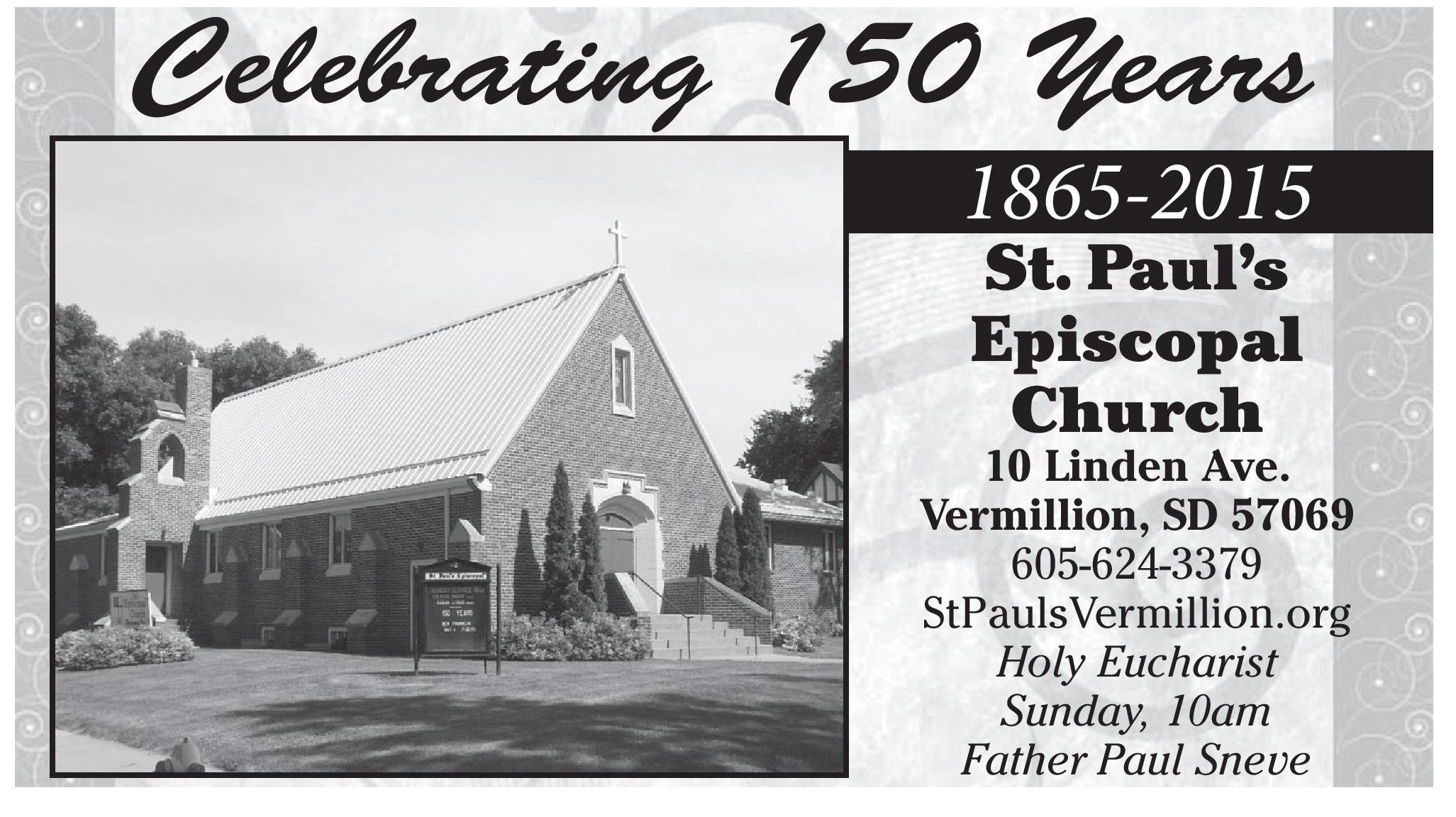



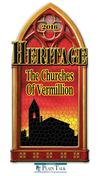
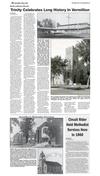
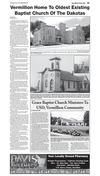
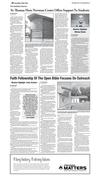




 Previous Page
Previous Page






